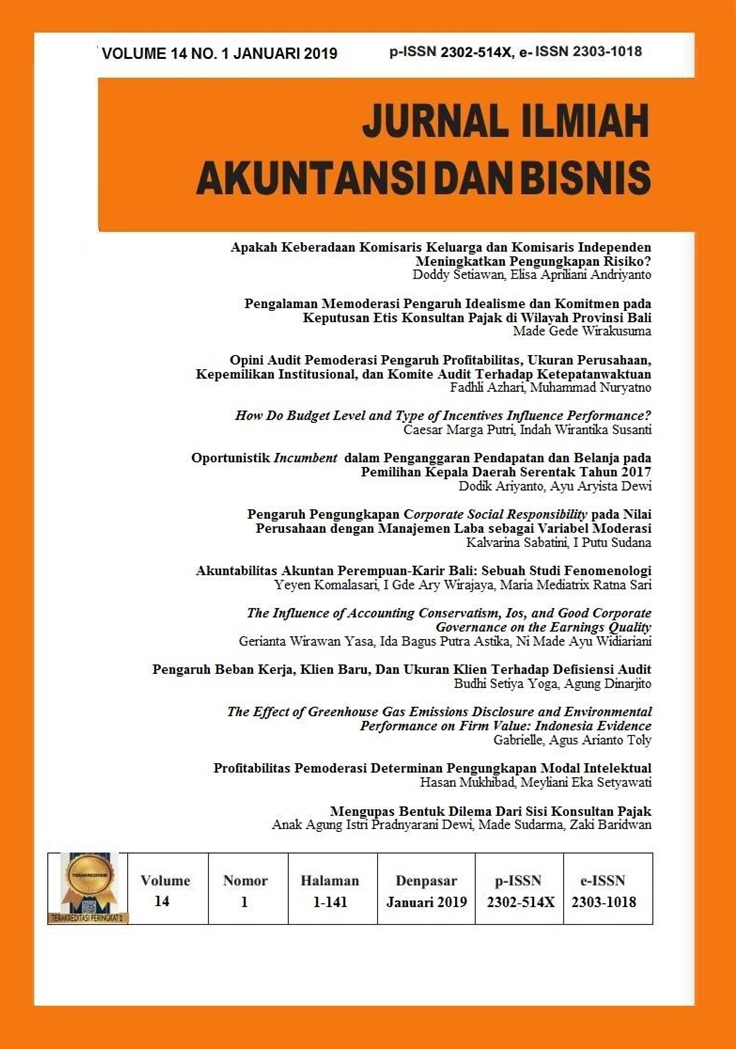Apakah Keberadaan Komisaris Keluarga Dan Komisaris Independen Meningkatkan Pengungkapan Risiko?
Abstract
This research aims to examine the effect of family commissioners and independent commissioners on risk disclosure using Indonesian firms that engaged in initial public offering (IPO). This research uses multiple regression analysis to test the effect of family commissioners and independent commissioners on risk disclosure. The study sample consists of 204 non-financial firms that engaged in IPO during the period of 2001–2017. The result of the study shows that family commissioners and independent commissioners have positively affected risk disclosure. Therefore, it is important for companies to add more independent commissioners and maintain family commissioners during IPO.
Keywords: family commissioners, independent commissioners, initial public offering, board of commissioner
Downloads
References
Allen, F., & Faulhaber, G. R. (1989). Signalling by underpricing in the IPO market. Journal of Financial Economics, 23(2), 303-323.
Bliss, M. A. (2011). Does CEO duality constrain board independence? Some evidence from audit pricing. Accounting & Finance, 51(2), 361 - 380.
Carney, R. W., & Child, T. B. (2013). Changes to the ownership and control of East Asian corporations between 1996 and 2008: The primacy of politics. Journal of financial economics, 107(2), 494-513.
Chen, E. T., Gray, S., & Nowland, J. (2013). Family representatives in family firms. Corporate Governance: An International Review, 21(3), 242 - 263.
Chen, S., Chen, X., & Cheng, Q. (2008). Do Family Firms Provide More or Less Voluntary Disclosure? Journal of Accounting Research, 46(3), 499-536. doi:10.1111/j.1475-679X.2008.00288.x
Chen, S., Chen, X., & Cheng, Q. (2008). Do family firms provide more or less voluntary disclosure? Journal of Accounting Research, 46(3), 499 - 536.
Davis, J. H., Schoorman, F. D., & Donaldson, L. (1997). Toward a Stewardship Theory of Management. The Academy of Management Review, 22(1), 20-47. doi:10.2307/259223
Ding, R. (2016). Disclosure of Downside Risk and Investors' Use of Qualitative Information: Evidence from the IPO Prospectus's Risk Factor Section. International Review of Finance, 16(1), 73-126. doi:10.1111/irfi.12066
Elshandidy, T., Fraser, I., & Hussainey, K. (2013). Aggregated, voluntary, and mandatory risk disclosure incentives: Evidence from UK FTSE all-share companies. International Review of Financial Analysis, 30, 320-333. doi:https://doi.org/10.1016/j.irfa.2013.07.010
Garanina, T., & Dumay, J. (2017). Forward-looking intellectual capital disclosure in IPOs: Implications for intellectual capital and integrated reporting. Journal of Intellectual Capital, 18(1), 128-148. doi:10.1108/JIC-05-2016-0054
Hopp, C., & Dreher, A. (2013). Do differences in institutional and legal environments explain cross-country variations in IPO underpricing? Applied Economics, 45(4), 435-454.
Jensen, M. C. (2010). The modern industrial revolution, exit, and the failure of internal control systems. Journal of applied corporate finance, 22(1), 43-58.
Kusumawardhani, T. (2012). Intellectual Capital, Financial Profitability, and Productivity: An Exploratory Study of the Indonesian Pharmaceutical Industry. Asian Journal of Business and Accounting, 5(2).
Linsley, P. M., Shrives, P. J., & Crumpton, M. (2006). Risk disclosure: An exploratory study of UK and Canadian banks. Journal of Banking Regulation, 7(3-4), 268-282.
Musteen, M., Datta, D. K., & Kemmerer, B. (2010). Corporate Reputation: Do Board Characteristics Matter? British Journal of Management, 21(2), 498-510. doi:10.1111/j.1467-8551.2009.00676.x
Ntim, C. G., Lindop, S., & Thomas, D. A. (2013). Corporate governance and risk reporting in South Africa: A study of corporate risk disclosures in the pre- and post-2007/2008 global financial crisis periods. International Review of Financial Analysis, 30, 363-383. doi:https://doi.org/10.1016/j.irfa.2013.07.001
Oliveira, J., Lima Rodrigues, L., & Craig, R. (2011). Risk?related disclosures by non?finance companies: Portuguese practices and disclosure characteristics. Managerial Auditing Journal, 26(9), 817-839. doi:10.1108/02686901111171466
Prabowo, M. A., & Simpson, J. (2011). Independent directors and firm performance in family controlled firms: Evidence from Indonesia. Asian-Pacific Economic Literature, 25(1), 121-132.
Probohudono, A. N., Tower, G., & Rusmin, R. (2013a). Diversity in risk communication. Australasian Accounting, Business and Finance Journal, 7(1), 43-58.
Probohudono, A. N., Tower, G., & Rusmin, R. (2013b). Risk disclosure during the global financial crisis. Social Responsibility Journal, 9(1), 124-137.
Probohudono, A. N., Tower, G., & Rusmin, R. (2013c). A risky tale of two countries. Asian Review of Accounting, 21(3), 257-272.
Pucci, T., Simoni, C., & Zanni, L. (2015). Measuring the relationship between marketing assets, intellectual capital and firm performance. Journal of Management & Governance, 19(3), 589-616. doi:10.1007/s10997-013-9278-1
Rochayani, W., & Setiawan, D. (2004). Pengaruh Informasi Prospektus IPO Terhadap Abnormal Returns Dan Ketepatan Ramalan Laba. Jurnal EKonomi Perusahaan, 11(2), 107 - 124.
Sahoo, S., & Rajib, P. (2010). After Market Pricing Performance of Initial Public Offerings (IPOs): Indian IPO Market 2002–2006. Vikalpa, 35(4), 27-44. doi:10.1177/0256090920100403
Setiawan, D., Bandi, B., Phua, L. K., & Trinugroho, I. (2016). Ownership structure and dividend policy in Indonesia. Journal of Asia Business Studies, 10(3), 230 - 252.
Shi, C., Pukthuanthong, K., & Walker, T. (2013). Does Disclosure Regulation Work? Evidence from International IPO Markets. Contemporary Accounting Research, 30(1), 356-387. doi:10.1111/j.1911-3846.2012.01158.x
Solomon, J. F., Solomon, A., Norton, S. D., & Joseph, N. L. (2000). A conceptual framework for corporate risk disclosure emerging from the agenda for corporate governance reform. The British Accounting Review, 32(4), 447-478. doi:http://dx.doi.org/10.1006/bare.2000.0145
Suhardjanto, D., & Dewi, A. (2011). Pengungkapan risiko finansial dan tata kelola perusahaan: Studi empiris perbankan Indonesia. Jurnal Keuangan dan Perbankan, 15(1), 105-118.
Thomadakis, S., Nounis, C., & Gounopoulos, D. (2012). Long?term Performance of Greek IPOs. European Financial Management, 18(1), 117-141.
Wan-Hussin, W. N. (2009). The impact of family-firm structure and board composition on corporate transparency: Evidence based on segment disclosures in Malaysia. The International Journal of Accounting, 44(4), 313-333. doi:https://doi.org/10.1016/j.intacc.2009.09.003
Widarjo, W. (2011). Pengaruh Modal Intelektual dan Pengungkapan Modal Intelektual pada Nilai Perusahaan yang melakukan Initial Public Offering. Jurnal Akuntansi dan Keuangan Indonesia, 8(2), 157 - 170.
Widarjo, W., Rahmawati, Bandi, & Widagdo, A. K. (2017). Underwriter Reputation, Intellectual Capital Disclosure, and Underpricing. International Journal of Business and Society, 18(2), 227-244.
Yoshikawa, T., & Rasheed, A. A. (2010). Family control and ownership monitoring in family-controlled firms in Japan. Journal of Management studies, 47(2), 274-295. doi:10.1111/j.1467-6486.2009.00891.x




















